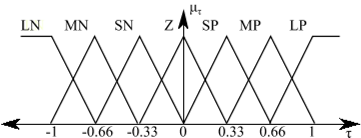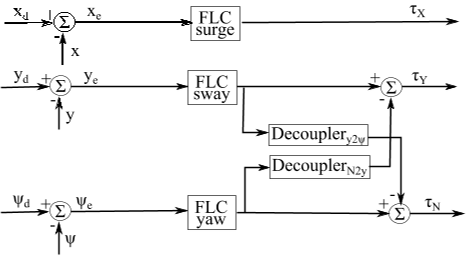Q2. What is the objective of the control system in this phase?
The objective of control system in this phase is to guide the error to zero while gradually decreasing the rate of change of error.
Q3. What is the effect of the FLC on the vessel?
The FLC is also successful in computing counter thrust that needs to be produced to minimise the effect of the wave disturbances so that vessel maintains its position and heading.
Q4. What is the thrust that the thruster needs to produce?
The thrust that the thruster needs to produce can be found as,τT =W−1AT (AW−1AT )−1τP (32)3.5 Nonlinear passive observerGenerally, only noisy measurement of the position and orientation are available through sensors.
Q5. What is the wave force of a research vessel?
The wave force are generated using mathematical model that considers the direction of the waves, the amplitude of the waves, the frequency of the waves and the geometry of the vessel.
Q6. What was the first paper to use a PID controller for dynamic positioning?
In that paper a proportional-integral-derivative (PID) controller was used for control while a simple linear sequential thrust allocation algorithm was used for furnishing the thruster rpm and the azimuth angle.
Q7. What is the simplest way to reduce the noise from position and heading?
In order to attenuate this undesirable, zero mean sinusoidal noise and filter the noise from position and heading signal, a nonlinear passive observer is utilised.
Q8. What is the maximum thrust required in the surge?
τPi = 100(τCi τmaxi)∣∣ ∣ ∣i=X,Y,N(27)τPX is the permissible thrust required in the surge, τ C Y is the permissible thrust required in the sway, and τCN is the permissible moment required in the yaw.
Q9. What is the effect of the sway FLC on the yaw?
In order to avoid effect of the sway FLC on the yaw and vice-versa, a feed-forward compensation decoupling technique is employed [35,2].
Q10. What is the optimum position and orientation feedback for the DP?
If these oscillatory disturbances enter the control loop through position and orientation feedback they may cause excessive thruster commands resulting in unacceptable mechanical wear and tear of the to thruster, excessive fuelconsumption and unacceptable operational condition.
Q11. What is the purpose of this paper?
The paper is an attempt to understand the capabilities of three segregated fuzzy logic controller, along with the decoupling mechanism, in tracking and con-x (m)-2 0 2 4 6y (m )-10123456Ref fuzzy LQR mvPIDFig.
Q12. What is the position and orientation vector of the vessel?
The position and orientation vector is represented by,η = [ x y ψ ]T(2)Where x is the displacement in the surge direction, y is the displacement in the sway direction and ψ is the heading angle.
Q13. What is the definition of the wave forces?
The wave forces are generated by passing a pseudo-random binary number (to simulate band limited white noise) through wave transfer function (given in equation 13) using the parameter mentioned in Table 4 and Table 8 [18].
Q14. What is the input-output relationship of the sway and the yaw?
The input-output relations of the sway and the yaw with respect to thrust in y-direction and moment about z-axis can be written as,y(s) = GY y(s)τY (s) +GNy(s)τN (s) (19)ψ(s) = GY ψ(s)τY (s) +GNψ(s)τN (s) (20)Where, the transfer functionsGY y(s),GNy(s),GY ψ(s),and GNψ(s) can be computed by substituting value from Table 1 and Table 2 in equation from 1 to 9 as,GY y(s) = 0.299s+ 0.005417s2 + 0.3904s+ 0.03783 (21)GY ψ(s) = −0.011s− 0.001092s2 + 0.3904s+ 0.03783 (22)GNy(s) = −0.011s− 0.00107ss2 + 0.3904s+ 0.03783 (23)GNψ(s) = 0.3663s+ 0.07586s2 + 0.3904s+ 0.03783 (24)The two subsystems can be decoupled by compensating for the coupling by introducing the element, given in equation 25 and 26 as shown in Fig. 3.DY 2ψ(s) =− GY ψ(s)GNψ(s) =0.011s+ 0.0010920.03663s+ 0.07586 (25)DN2y(s) =− GNy(S)GY y(s) =0.011s+
Q15. What is the difference between the fuzzy controller and the PID?
It should also be noted that tuning LQR requires an exact mathematical model of the system, where as in case of fuzzy controller an imprecise system model is sufficient for the controller design.





